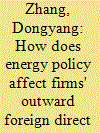|
|
|
Sort Order |
|
|
|
Items / Page
|
|
|
|
|
|
|
| Srl | Item |
| 1 |
ID:
192322


|
|
|
|
|
| Summary/Abstract |
As urbanization and economic development continue to accelerate, social equity issues are becoming increasingly prominent and the urban–rural income gap is an important manifestation of this. This study uses the data of urban clusters from 2010 to 2019 and focuses on the relationship between the polycentric spatial structure of urban clusters and the urban–rural income gap. The findings show that the development of urban cluster polycentricity can reduce the urban–rural income gap, and the higher the degree of polycentricity in morphology, the smaller the gap. However, the relationship between polycentric spatial structure and the urban–rural income gap is “U” shaped, indicating the need for rational planning of urban polycentric development patterns rather than simple expansion. In addition, the polycentric spatial structure of urban clusters can reduce regional disparities by promoting factor mobility and industrial structure optimization. However, this depends on the level of industrial development and infrastructure. This study highlights the importance of a balanced approach to urban development that takes into account regional disparities and issues of social equity.
|
|
|
|
|
|
|
|
|
|
|
|
|
|
|
|
| 2 |
ID:
181472


|
|
|
|
|
| Summary/Abstract |
Energy policy can improve the efficiency of firms' outward foreign direct investment (OFDI) and promote the quality of China's economic growth, which is an important issue requiring urgent attention from Chinese society. Using the data of A-share listed companies from 2007 to 2018, this paper examines the impacts and mechanisms of both new and traditional energy policies on firms' OFDI. First, this study found a significant positive promotion effect from energy policy on firms' OFDI. Second, the heterogeneity test results suggest that an increase in the level of urban openness may weaken the positive effect of new energy policies on firms' OFDI, but may enhance the promotion effect of traditional energy policies. State ownership is conducive to enhancing firms' OFDI under new energy policies. However, such ownership can weaken the willingness of firms to invest abroad under traditional energy policies. Third, the mechanism analysis shows that new energy policy promotes firms to invest in technologically developed host countries, thus expanding the scale of firms' OFDI in the next round. Energy policies can improve firms' business and environmental performances in the short run; in the long run, this effect diminishes year by year.
|
|
|
|
|
|
|
|
|
|
|
|
|
|
|
|
| 3 |
ID:
178843


|
|
|
|
|
| Summary/Abstract |
Generally, public spending on education, research, and development (R&D) is perceived to impact the economy and sustainability positively; however, such notion lacks evidence, particularly in Belt and Road Initiative (BRI) member countries. In this study, panel data of BRI member countries from 2008 to 2018 is analysed using the generalized method of moments (GMM) method and data envelopement analysis (DEA) to assess the relationship between public spending on R&D and green economic growth and energy efficiency. The study found a fluctuating green economic growth indicator during the research period attributed to the non-serious nature of government policies. The findings reveal that the GMM method confirms both composition and technique effects in the entire sample. Nonetheless, the result of the sub-sample showed a heterogeneous effect on high GDP per capita countries. Moreover, the study shows that public spending on human resources and R&D of green energy technologies prompts a sustainable green economy through labour and technology-oriented production activities and different effects in different countries.
|
|
|
|
|
|
|
|
|
|
|
|
|
|
|
|
|
|
|
|
|